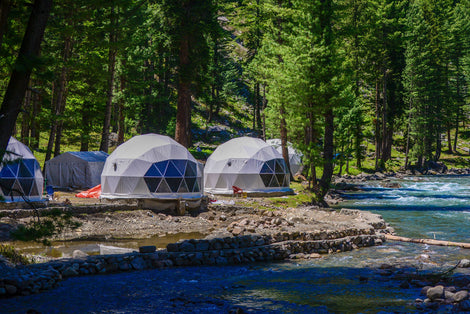Food Preservation Challenges in Off-Grid Settings
Living off the grid comes with a lot of freedom, but it also brings some challenges you don’t always think about until you're deep into the lifestyle. One of the biggest hurdles? Keeping food fresh and stored safely without relying on traditional power sources. Since off-grid setups depend on alternative energy like solar, how you store food has to work with your energy system, not against it. That means food preservation becomes a priority, especially when you're trying to reduce waste and make the most of every harvest or grocery trip.
What makes food storage tricky in these situations is that off-grid homes often don't have access to standard electrical appliances, or they need to use power carefully to make it through cloudy or low-production days. This means it's not just about what food you store but how. The focus shifts toward smart solutions that work with the natural rhythms of your energy system and the seasons. Whether you're homesteading or just spending weekends off the grid, being ready with a preservation plan is one of the smartest steps to take.
Understanding Food Preservation Off-Grid
Off-grid living centers around one goal: self-sufficiency. That means budgeting every watt of electricity as carefully as your water or food. Since most standard refrigerators and freezers pull steady power 24/7, they can easily strain a solar setup, especially during times when sunlight is limited. So when you think about food preservation off-grid, you can't count on traditional ideas. You've got to approach it with flexibility and long-term planning.
Here’s why food preservation matters so much in this lifestyle:
- Energy use is limited, and having backup food you can rely on helps stretch your system during bad weather.
- Getting to a grocery store might not be easy or convenient, especially for those in more remote areas.
- Growing your own food or buying in bulk is common in off-grid homes, so storage becomes a year-round need.
All of this makes preservation more than just a backup plan. It’s part of how the household runs day to day.
Challenges Of Food Preservation In Off-Grid Settings
There are three main roadblocks when it comes to storing food safely and long term while living off-grid: power limitations, changing seasons, and exposure to temperature extremes. If you’re relying on solar energy, your food system has to match your energy output or it could fail when the sun disappears for a few days.
Let’s break it down a bit more:
1. Limited access to traditional refrigeration
Most fridges are designed to be plugged into the grid. They expect constant power. In an off-grid setup, unless you're investing in ultra-efficient models or solar-powered options, running a traditional fridge full-time isn’t realistic. And if you try to do it anyway, your power bank might run out faster than it charges.
2. Seasonal challenges
Summer brings plenty of sunlight, but that also means higher temps that spoil food faster. Winter brings lower temps, which can help preserve food naturally, yet may also coincide with weaker solar production, especially if your panels are snow-covered or daylight is short. Both seasons require different preservation strategies.
3. Energy management
Solar systems need a steady balance. If your food appliances are drawing too much power, you might not have enough left for lighting, heating water, or anything else. That balance often means turning to other preservation methods that don’t rely on a lot of electricity.
One example is someone who switched from a full-size freezer to a combination of solar refrigeration and a small freeze dryer machine for home use. That small change freed up enough energy to cook with an induction burner during peak daylight hours while still preserving bulk food like fruits and meats.
These challenges don’t make off-grid food storage impossible, but they do mean it takes a little more planning. Long-term food security depends on having layered systems. Your choices need to work with your energy source, with your climate, and with the lifestyle you’re living.
Effective Methods For Off-Grid Food Preservation
Once you understand the challenges, the next step is figuring out which methods actually work best with solar-powered systems. Your goal should be to conserve energy while keeping food safe over longer periods. That requires using tools and techniques that don’t lean on power-hungry appliances.
One of the most straightforward solutions is switching to appliances designed to run on solar. Solar-powered fridges and freezers come in various sizes and are built to work efficiently with direct current power. They cycle less often and usually have better insulation than standard units. Though their upfront cost may be higher, they often make up for it by using less power long-term.
Some tried-and-true methods also come into play, especially when you want to avoid relying on refrigeration at all:
- Canning: Great for vegetables, pickles, and jams. Once sealed, jars can last through seasons without refrigeration. Best done in bulk during harvest time to cut down on energy used during cooking and prep.
- Fermentation: Useful for preserving veggies like cabbage or cucumbers. It not only preserves but also enhances food with flavor. Fermented items can usually be stored in cool, dark places without anything plugged in.
- Freeze drying: Using a freeze dryer machine for home use can change the game. It lets you store bulk food—fruits, cooked meals, meats—without the need for constant power afterward. While the freeze drying process itself does use electricity, you can run it during peak sunlight hours to make the most of your solar kit’s output.
Someone with a medium-sized off-grid system may choose to set timers on appliances like the freeze dryer to run only when energy storage is full. This way, they avoid pulling energy during low-output hours and still get the benefit of long shelf life foods that don’t require active refrigeration once processed.
Every method should be part of a broader plan that fits your energy setup, food type, and daily needs. Mixing newer tech with low-tech preservation creates more reliable results without draining your solar reserves.
Maintaining Efficiency And Safety In Food Storage
Preserving food off the grid is more than just keeping it from going bad. You also need to think about long-term safety and keeping your system running smoothly. When your preservation method is built around solar kits, every small habit matters.
Start by syncing your food tasks with your solar system's activity:
- Run energy-heavy equipment, like freeze dryers or electric stoves, when the sun is high and your battery is full.
- Avoid plugging in multiple appliances at once unless you have a large system that can handle the load.
- Use timers to run dehydrators or freezers during peak sunshine rather than overnight.
Cleanliness is another factor that helps avoid wasted food. A sealed jar will last a while, but if the lid wasn’t properly sterilized or there's moisture, you could lose that batch. Stick to safe prep habits whether you're fermenting sauerkraut or vacuum-sealing vegetables. A well-made but contaminated food item wastes your time, money, and energy. None of which you want to throw away when you're living off-grid.
Check food often, especially in homemade cold storage or less stable climates. Wild temperature swings can impact quality. Simple thermometers in storage areas help give you a heads-up before you end up with spoiled food.
When it comes to safety and efficiency, it's about building a system and sticking to it. That cuts surprises and helps your solar power go further.
Staying Prepared Year-Round Off The Grid
Off-grid setups work best when you plan around the year instead of just the season. That means thinking a few steps ahead each time you harvest, visit the store, or adjust your energy setup.
Don’t wait until you’re facing a stretch of cloudy days or lower sunlight hours to think about food storage routines. Your energy levels and available sunlight will shift. So should your approach. Make a habit of checking what preservation methods fit the season and your battery’s state. Some folks use the sunniest parts of fall to run freeze dryers nonstop, creating stockpiles of meals they can lean on all winter without running anything else.
To keep things practical, here’s what planning ahead might look like:
- Track how much sunlight and energy you get each season.
- Use spring and summer to process and store foods that’ll carry you through the colder months.
- Let cooler temperatures work in your favor. Use root cellars, porch storage, or unheated sheds to hold root vegetables and canned goods.
- When the days are shorter, scale down on power-hungry preservation methods and lean into low-energy storage options.
Having a flexible system in place gives you more peace of mind year-round. Pairing preservation efforts with solar strength keeps both your power and your pantry steady. The key is to keep adapting without straining your setup or facing surprise shortages.
Each method won’t work everywhere or for everyone, but having a few options to pull from makes food prep and long-term storage a lot more reliable off-grid. It’s all about building a rhythm between energy use, smart practices, and seasonal awareness.
Ready to transform your off-grid living with innovative food storage options? Learn how our solar kits can power a freeze dryer machine for home to help you store food efficiently without putting a strain on your energy supply. Trust Green Vista Living to support your journey toward a more sustainable lifestyle.







